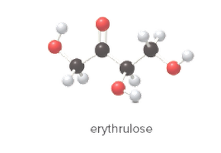
EBK GENERAL, ORGANIC, & BIOLOGICAL CHEM
3rd Edition
ISBN: 9781259298424
Author: SMITH
Publisher: VST
expand_more
expand_more
format_list_bulleted
Concept explainers
Question
Chapter 15.3, Problem 15.7P
Interpretation Introduction
Interpretation:
The chiral center in following compound should be located.

Concept Introduction:
Compounds containing four different groups attached to them are known as chiral compound and that carbon is known as chiral carbon. The chiral carbon in the given compound is represented by placing an asterisk (*) symbol over that carbon atom.
Expert Solution & Answer
Want to see the full answer?
Check out a sample textbook solution
Students have asked these similar questions
7
Comment on the general features of the predicted (extremely simplified) ¹H-
NMR spectrum of lycopene that is provided below.
00
6
57
PPM
3
2
1
0
Indicate the compound formula: dimethyl iodide (propyl) sulfonium.
Pls help asap
Chapter 15 Solutions
EBK GENERAL, ORGANIC, & BIOLOGICAL CHEM
Ch. 15.1 - Prob. 15.1PCh. 15.1 - For trans-2-hexene: (a) draw a stereoisomer; (b)...Ch. 15.2 - Prob. 15.3PCh. 15.2 - Prob. 15.4PCh. 15.3 - Prob. 15.5PCh. 15.3 - Prob. 15.6PCh. 15.3 - Prob. 15.7PCh. 15.3 - Prob. 15.8PCh. 15.3 - Prob. 15.9PCh. 15.3 - Prob. 15.10P
Ch. 15.3 - Prob. 15.11PCh. 15.4 - Prob. 15.12PCh. 15.4 - Prob. 15.13PCh. 15.5 - Prob. 15.14PCh. 15.6 - Prob. 15.15PCh. 15.6 - Prob. 15.16PCh. 15.6 - Prob. 15.17PCh. 15.7 - Prob. 15.18PCh. 15.7 - Prob. 15.19PCh. 15.7 - Prob. 15.20PCh. 15.7 - Prob. 15.21PCh. 15.8 - Prob. 15.22PCh. 15.8 - Prob. 15.23PCh. 15.9 - Prob. 15.24PCh. 15 - Prob. 15.25PCh. 15 - Prob. 15.26PCh. 15 - Prob. 15.27PCh. 15 - Prob. 15.28PCh. 15 - Prob. 15.29PCh. 15 - Prob. 15.30PCh. 15 - Prob. 15.31PCh. 15 - Prob. 15.32PCh. 15 - Prob. 15.33PCh. 15 - Prob. 15.34PCh. 15 - Prob. 15.35PCh. 15 - Prob. 15.36PCh. 15 - Prob. 15.37PCh. 15 - Prob. 15.38PCh. 15 - Prob. 15.39PCh. 15 - Prob. 15.40PCh. 15 - How are the compounds in each pair related? Are...Ch. 15 - Prob. 15.42PCh. 15 - Prob. 15.43PCh. 15 - Prob. 15.44PCh. 15 - Answer each question with a compound of molecular...Ch. 15 - Prob. 15.46PCh. 15 - Prob. 15.47PCh. 15 - Prob. 15.48PCh. 15 - Prob. 15.49PCh. 15 - Prob. 15.50PCh. 15 - Prob. 15.51PCh. 15 - Prob. 15.52PCh. 15 - Prob. 15.53PCh. 15 - Prob. 15.54PCh. 15 - Prob. 15.55PCh. 15 - Prob. 15.56PCh. 15 - (a) Define the terms “optically active” and...Ch. 15 - Prob. 15.58PCh. 15 - Prob. 15.59PCh. 15 - Prob. 15.60PCh. 15 - Prob. 15.61PCh. 15 - Prob. 15.62PCh. 15 - Prob. 15.63PCh. 15 - Prob. 15.64PCh. 15 - Prob. 15.65PCh. 15 - Prob. 15.66PCh. 15 - Prob. 15.67PCh. 15 - Prob. 15.68PCh. 15 - Prob. 15.69PCh. 15 - Prob. 15.70PCh. 15 - Prob. 15.71PCh. 15 - Prob. 15.72PCh. 15 - Prob. 15.73CPCh. 15 - Prob. 15.74CP
Knowledge Booster
Learn more about
Need a deep-dive on the concept behind this application? Look no further. Learn more about this topic, chemistry and related others by exploring similar questions and additional content below.Similar questions
arrow_back_ios
SEE MORE QUESTIONS
arrow_forward_ios
Recommended textbooks for you
